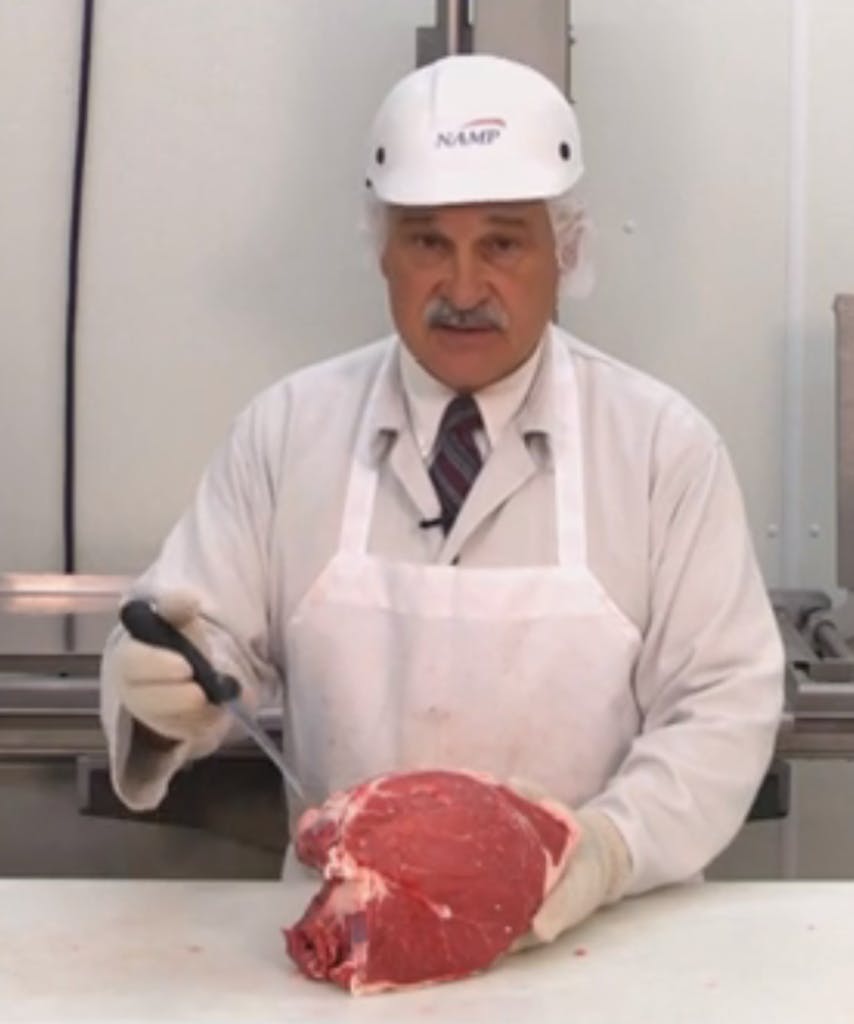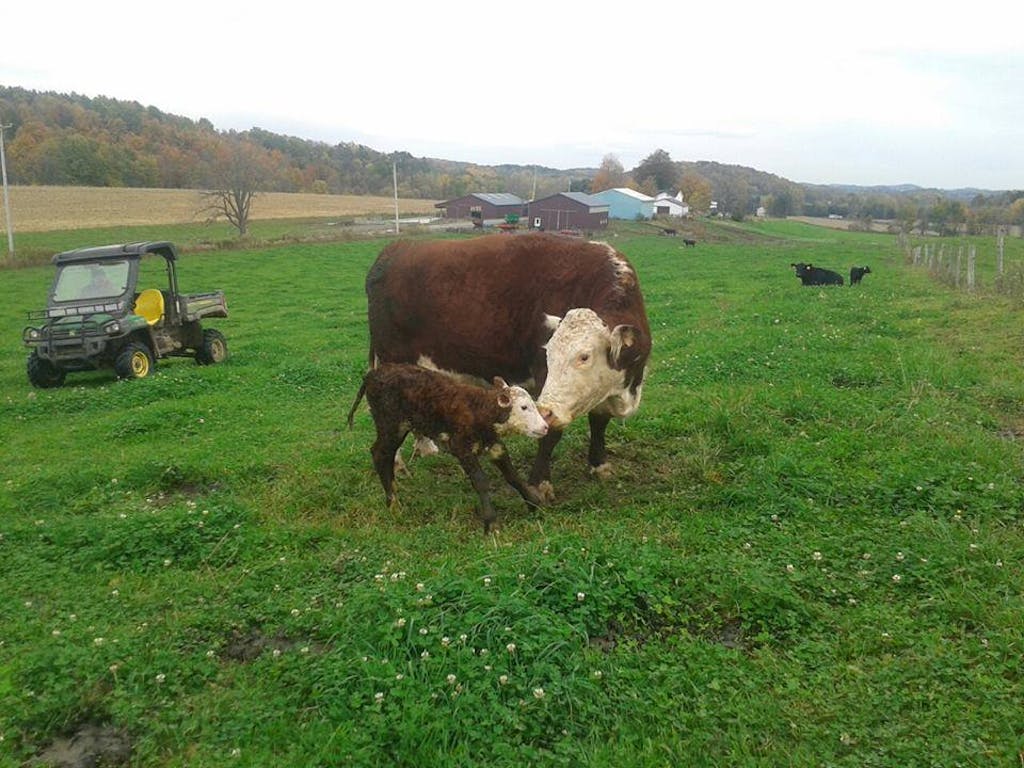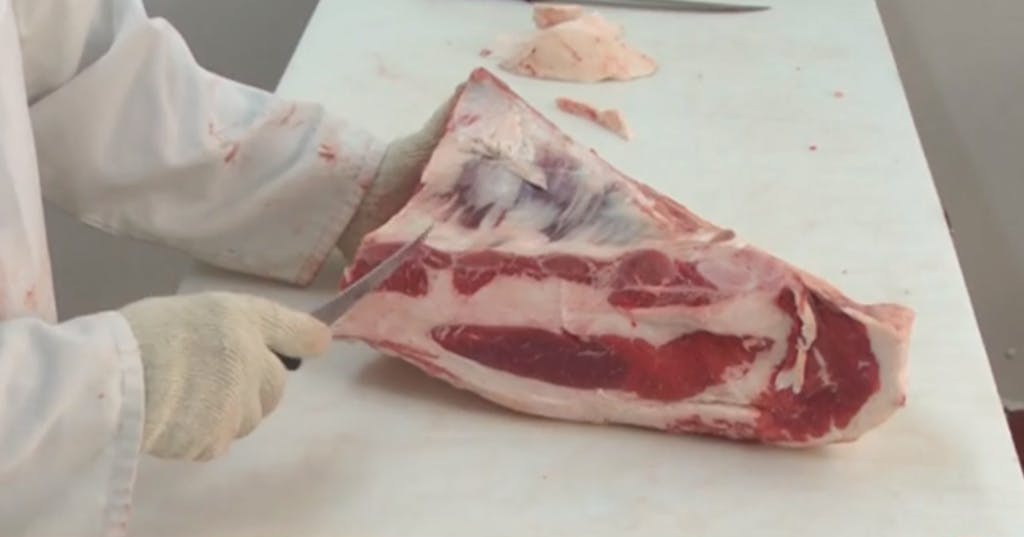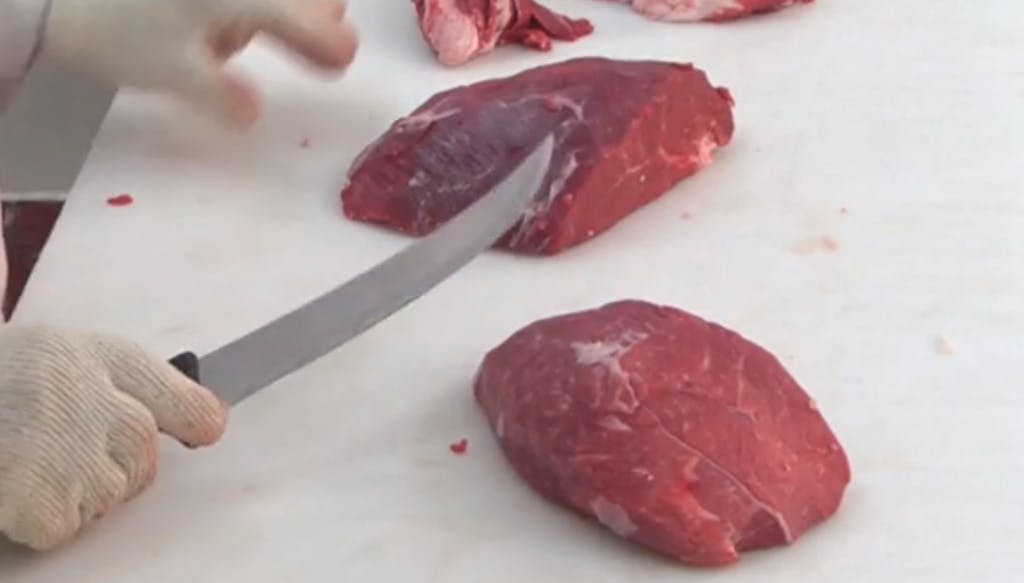
Owner: Hidden Canyon Farm in Lyons, New York
Author: Institutional Meat Purchase Specifications (IMPS)
If you’ve ever purchased a cut of meat then you’ve been impacted by IMPS. IMPS, or the Institutional Meat Purchase Specifications are the guidelines for most of the beef cuts you purchase in the U.S. whether you’re familiar with them or not. NAMP or the North American Beef Processors Association has taken the text-only IMPS guide and made it more user friendly with color photos showing the different cuts and their adjacencies. If you subscribe to their online guide you can even see helpful videos of carcasses being broken down into individual cuts. And the only man starring in those videos is Steve Olson. I’ve watched literally hours of him cutting beef, but I didn’t know that when we first spoke. A few sentences in I realized this was the distinctive voice that had guided me through deckle removal and the finer points of a square cut chuck. He could only laugh at my moment of clarity.
Steve Olson was the main author of the version of IMPS that we use today. They’ve been referenced routinely in any of the columns dealing with meat anatomy. Before our conversation, I asked Steve via email to share a bit of the history of IMPS:
The Meat Buyers Guide’s predecessor, the Institutional Meat Purchase Specifications were first developed in the late 1950’s (for Beef it was 1958 precisely) to replace a the National Association of State Purchasing Officials (NASPO) Meat Purchase Specifications. The NASPO specs were the only set of National meat purchase specifications at the time. They were designed so that they could be used for inspection for contract compliance. They were developed on a voluntary consensus basis, which means that the production segment of the industry had input with the State Purchasing Officials of all 48 states and 9 territories at the time. However, the specifications were purchaser biased, they were designed to meet the purchaser needs not necessarily what the producer wanted to sell. It is important to understand that the NASPO specifications were not regulatory. Coordination among the states to gain concurrence of any revisions became difficult, particularly during the early days of refrigerated shipment and packaging technology changes.
The USDA’s Consumer Marketing Service, now known as the Agricultural Marketing Service (AMS), supplied a certification service for the states conducted by their Meat Grading Branch. The meat graders would ‘certify’ meat products at point of production for contract compliance. NASPO requested that USDA maintain the meat specifications provided that they (1) would not become regulatory; (2) maintained on a voluntary consensus basis; (3) written so that product can be inspected at point of delivery; and (3) USDA continues to provide a certification service for States to use, if desired, to determine compliance at point of production.
If you’d like to see some of Steve’s on camera work, you’ll have to subscribe to the Electronic Meat Buyer’s Guide yourself, but online access to the IMPS is free.
Daniel Vaughn: How long have you been ranching in New York?
Steve Olson: I was born and raised in Lyons, New York. My dad raised beef cattle and hogs when I was a youngster. I wanted to see how the other side of the world lived, so I went to Kansas. I got a degree in animal science from Kansas State and joined the USDA only because I didn’t know what I wanted to do yet. After thirty-two years there, I came back home.

DV: What sort of work did you do for the USDA?
SO: I had a career like Forrest Gump with the meat industry. All the jobs I ever had with USDA were assignments I got because nobody else wanted to do it. Have you read the meat buyer’s guide?
DV: Yes.
SO: Can you imagine writing that? C’mon! Who else would know that the complexxis muscle is less than twice the size of the longissimus when you cut a beef carcass between the fifth and sixth thorasic vertebrae? I mean, that’d really be a big hit at a cocktail party.
DV: It’s important stuff. Getting consistent beef and consistently sized cuts can be challenging for pitmasters, especially for brisket.
SO: Part of the problem with consistency is the cut itself. You have a big wad of wedge fat on the nose end. When I see them slicing a brisket at a Texas barbecue joint and they start getting close to that line of fat, I go to the back of the line and let others go in front of me to get that fat. I like meat, not fat. The flat cut makes sense to me. Everybody should get the same slice. The restaurant industry is about consistency. It’s more appropriate just to chop up the point, fat and all.
DV: I might disagree, but the whole reason for the IMPS guide was for some level of consistency. When did you begin your work on it?
SO: I inherited the IMPS guide in 1983. The first one was developed in 1958. The guys who wrote that were just retiring when I got there.
DV: What did the guide look like then? Had it changed much in those twenty-five years?
SO: Yes and no. In 1958 they were very detailed about how to dress the animal and what to remove. It identified ligaments to be removed and how to remove the heart fat, things like that. What I did, or what we did…we needed to know the muscles and to explain the anatomy. I did a lot to get the muscle information in the specifications and it has worked well. I say that because they’ve held up well in litigation. Remember, this isn’t regulatory. It is not a law. It’s for contractual use.
DV: So any meat market could butcher their meat however they like, but they use the IMPS as a default because everyone is familiar with it?
SO: Yes. A lot of butchers will say “We cut the NAMP cuts.” It’s good, but a lot of them probably have an outdated version. It’s all about how much the people buying it are paying attention. I know some restaurants are very meticulous about what they buy and others aren’t.
DV: A lot of butchers also say they only sell USDA inspected beef.
SO: Well, that’s a law. You have to.
DV: What’s the difference between IMPS and NAMP?
SO: IMPS is developed by the USDA. In 1961 the first NAMP meat buyer’s guide came out, and it was just a pictorial version of the USDA specifications. IMPS is just an item description.
DV: So NAMP just makes the good looking guide.
SO: Yep. Anybody can do it because IMPS is public domain.
DV: How did you get involved specifically in writing the IMPS guide?
SO: I had a little bit of background in the beef industry. I cut meat through college and grew up around cattle. I understood the anatomy. I also worked as a beef grader in New York beef packing plants. I also had an advantage over everyone else. I was a lousy writer.
DV: The beef standards didn’t need to be great prose.
SO: That’s right. I was a lousy student so when I got thrown into it I had to work harder. I started with the USDA in Sioux City, Iowa in 1977. Then I transferred to Norton, New Jersey. Like I said. I got jobs nobody else wanted. At one time I was in Piqua, Ohio on a relief assignment. I was the only grader on the whole country doing Certified Angus Beef back in 1978. It was just one plant. To tell if it was Angus, they’d cut off the ear and pin it to the inside of the carcass.
DV: That was the official stamp, eh?
SO: You bet. [laughing]. It was there in a motel in Piqua when I got a forwarded letter saying they had a position opening up in Washington for a specification writer. That sounded great. In the summer of ’79, I showed up in Washington and my first assignment was to go to meeting involving Natick research and development laboratories talking about thermal-stabilized retortable pouches. That’s before they called it the MRE. It wasn’t until 1983 that IMPS came along.
DV: What all did IMPS cover then?
SO: It wasn’t just beef. I had to be well versed in pork, lamb, veal, and sausage products. I would get information from contacts all over the country. It wasn’t just me. You’ll even see some influence from Australians and New Zealanders. When I worked with the UN I had a lot of interaction with the Europeans. It was the Germans that taught them how to cut beef in Argentina.
DV: In the U.S., beef cutting seems to be more organized around cutting along certain lines drawn over the carcass. With all the different styles of cutting beef around the world, are there others that follow the natural seams in the muscles more closely?
SO: Yes. The first time I saw that was in Holland, then in Germany. A lot of their beef is bull beef. Their animals look like draft animals. They’re tough as nails. They’d individualize muscles and get tenderness out of how they cooked it.
DV: What was the beef cuts look like in the U.S. before IMPS? Was it just a free-for-all when it came to cutting beef?
SO: Yes and no. The original IMPS was a purchase specification. You had quite a bit of detail put out by Swift, Armour, and Oscar Mayer that standardized the cuts.
DV: Were the standards different from state to state?
SO: In the old days of the meat industry we had the HRI trade. Some purveyors called themselves an HRI house. It stands for Hotel, Restaurant, and Institutions. You’d get the really good cuts of beef and sell it the hotels first. What they wouldn’t buy went to the restaurants. Then if you couldn’t sell it to those guys you’d dump it on the institutions. Institutions can be hospital, anyone in the government or military, schools…They had to follow a system of procurement called competitive bid – low bid wins. It’s important to understand this because it’s the whole reason there are such detailed specifications. You can imagine if you’re a buyer and you’re going out in the marketplace to buy, let’s say, a whole load of shoulder clod. If you don’t have a detailed specification, then what do you think you’re going to get from the low bidder? They’re gonna dump on you. You had to arm yourself with the specifications. In the interest of quality assurance we built the meat guides. Look at the Army. The world’s largest meat buyer is the Department of Defense. There was a lot of money at stake, and they wanted to make sure what they were receiving is what they paid for. They were the first ones to really write in detail what they wanted in the cuts and what they wanted removed. It wasn’t until 1958 when they first started requiring spinal cords to be removed. That amazes me. They should have been removing it anyway. Who eats that? It’s just weight. It’s a way to sell something that you’d otherwise throw away. That was the attitude of the meat industry. Your best customer is someone who didn’t know anything.
DV: And the IMPS guide that you helped author gave them the ability to gain that knowledge.
SO: I was a government employee. I didn’t have a bias toward any producer or purchaser. My idea was that I wanted to put down a common language that people could understand. If you know those specs well, you’ll be a smart buyer. If you don’t then you’ll get screwed and tattooed. That’s the way it goes.
DV: Looking back at the history of Texas barbecue, the meat came from the forequarter. Brisket is our most popular cut now, but it wasn’t always any more popular than any other forequarter cut. Back before there was an IMPS guide, would we recognize what the meat markets were selling then? Would they have been cutting briskets that look like the briskets we eat today? Was there a precedent they’d all be using to come up with similar cuts for the meat case and for the smoker?
SO: Yes. A lot of the way beef would be cut in Texas came from San Antonio with several huge military bases around there bringing in tons of beef. The very first briskets go along with the IMPS description. If you look at Item #118, which is a beef brisket bone-in, you’ll notice that it says to remove from “the cartilaginous juncture of the 1st rib and the sternum” and use a straight cut to go to the rib end side. That was a simple hand saw cut to a landmark. Then the damn Texans started cooking that thing.

DV: So there was a good chance that the briskets being smoked in the twenties and thirties would look like the briskets we use today?
SO: That’s a true statement. The square cut chuck [that the brisket comes out of] has been around forever.
DV: So that would also include the chuck short ribs and the shoulder clod, correct?
SO: Yes. Then the in 1970’s they started talking about boneless briskets.
DV: When did boneless briskets become the norm?
SO: About 1975. Remember this. Between 1975 and 1980 was when they really finessed the vacuum packaging material. A lot of the reasons why we cut meat the way we do is our ability to package it. They used to use stocking net and wrap the meat in that. Then W R Grace Company developed Cryovac in the seventies. They were trying to get the industry to make everything boneless so the Cryovac wouldn’t leak. They didn’t want bones to burst the bags.
DV: Do you still see bone-in briskets being sold in the U.S.?
SO: Not really, but I still see deckle-on briskets when I’m in Texas. I saw them in a butcher shop in Fredericksburg. They like to leave the deckle on to protect it from the heat of the fire, but 99% of the time in Texas you’ll see the IMPS #120 brisket with the bones and deckle removed.
DV: That makes some sense since they cook with direct heat in the Hill Country and that extra layer would help protect the briskets from that direct-heat cooking.
SO: To be honest I’m not a big fan of brisket. Being from upstate New York, a popular item for beef barbecue is the chuck roll.
DV: What other cuts are we ignoring that could work well for barbecue – for low and slow cooking?
SO: The old Kenny Rogers chain was using the #167E center roast of the knuckle. That’s a great rotisserie item. It’s the rectus femoris muscle, or the sirloin tip. The tri-tip is right next to that cut. There’s a new one called beef tips that I’m seeing at barbecue houses. They use the flap that also right next to the tri-tip. It’s a coarse texture, but it soaks up marinade beautifully and has that characteristic sirloin flavor. Another cut getting popular in Mexico is using the flanken short rib gets cut across the rib bones. I’m surprised you don’t see a lot in Texas yet.

DV: We smoke the whole racks of beef ribs around here whether it’s the four bone chuck rib racks or the three bone plate ribs racks.
SO: You know the meat on those plate ribs is what they call pastrami meat.
DV: So is that they navel?
SO: Yes. Navel is just another name for plate. If you go back to Swift and Co. in Chicago, the brisket and the short plate was all one cut. They would remove that from the forequarter and it was called the full navel.
DV: Was that sold as bone-in?
SO: Yes. That was before boxed beef. Boxed beef didn’t come into play until 1963. Kenny Montfort started doing that, then the guys who started IBP came from Montfort. IBP are the ones that really manifested boxed beef. They first called it Cattle Pak. They shipped larger cuts.
DV: So, they weren’t shipping out just boxes of briskets initially?
SO: Not at first. The individual cuts came later. Like I said, the boneless brisket came in the seventies. The flat itself became very popular in 1996. That’s the year of the Nutritional Labeling Act. If you can imagine how the fat per serving was expressed on a whole brisket versus a flat cut brisket…It was already popular in the Northeast for corned beef, but in 1996 it became more popular because it was lean. The trimming also changed with the labeling standards. It was common to leave a 1/2” of fat on the meat before 1996, but that quickly changed to 1/4” or an 1/8” to make the labels look better.
DV: Now you’re back home in Lyons, New York and you’re a full time rancher.
SO: That’s right. I raise Red Angus, Herefords, and Black Angus. I won’t say I’ve got the best beef in the world, but I cut it up myself. If you buy beef from me you get the baseball steaks and the Denver cut. You get the real deal. With all the value I add to the carcass, now you’ve got the best beef you can get. I put a lot of quality into it with the knife.
You can also see Steve Olson explain all varieties of retail meat cuts at the NAMA Center of the Plate Training at Texas A&M on June 3-5,2014.







